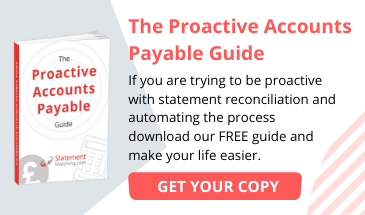Accounts Payable (AP) departments often feel they are forced to work reactively with limited resources. What systems and processes can be put in place to break this cycle?
Suppose Accounts Payable could act more proactively in the key area of supplier statement reconciliation – a virtuous circle would form where problems are addressed promptly and suppliers are paid faster.

To enhance the accuracy of cash flow forecasts and accruals, businesses reconcile their supplier accounts to identify and address any discrepancies between the amount the supplier claims you owe and the figures on the ledger. Lost invoices and late payments can all lead to a misleading and confusing cash flow position. Statementmatching.com – our browser-based vendor reconciliation solution – makes these kinds of AP issues a thing of the past.
Payment on-time performance is a primary KPI for Accounts Payable on the purchasing side and Accounts Receivable (AR) on the supplier side. As well as improving the relationship between your business and its vendors, paying suppliers promptly provides greater efficiencies, assists contract negotiation and reduces supply chain disruption.
It’s understandable; if a supplier hasn’t been paid, they will want to know why and this involves phone calls, emails and demands on your time that could be better spent on other tasks. Moreover, a supplier that has been unpaid on a long-term basis may be motivated to cease supplies or even stop trading altogether, causing disruption. Ensuring that suppliers are paid on schedule means that time-consuming queries are kept to a minimum whilst optimising supplier confidence in your business.
In an ideal world, GR/NI balances should be released within a short period. Reducing GR-NI balances goes straight to Profit and Loss, and supplier statement reconciliation helps the process by pinpointing suppliers with correctly processed invoices so you can confidently clear any GR-NI balances.
The best way to scrutinise that your supplier liabilities are completely accurate is to do supplier statement reconciliation to make sure all documents have been posted, received and that there are no erroneous invoices on the supplier’s account. Accurate supplier liabilities mean that financial reporting is accurate, and it’s an essential control for auditing and compliance.
To find out more about automated supplier statement reconciliation, download our FREE PDF “The Proactive Accounts Payable Guide”. To find out more about StatementMatching.com download our Solution Overview PDF or book a FREE Live Demo.

Book a live demo to see the end-to-end processes on live customers systems and learn how easy it is to try this for free on a Proof of Concept.
Book a Live Demo to see the end-to-end processes on live customers systems and learn how easy it is to try this for free on a Proof of Concept.
